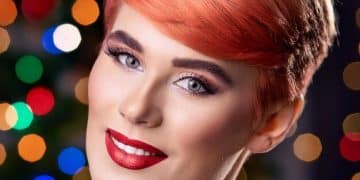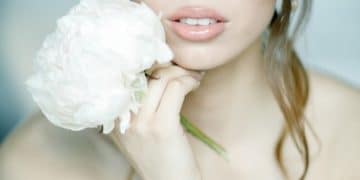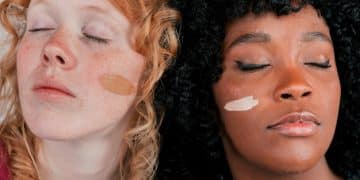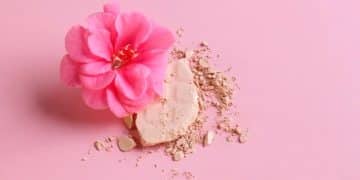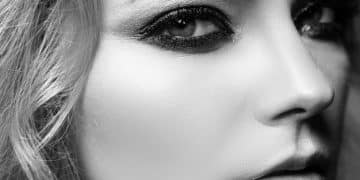Optimal Eyeshadow Palettes for Every Eye Color: 2025 Guide
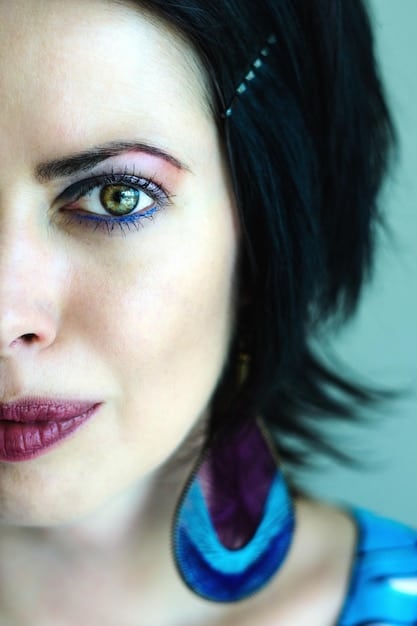
Choosing the right eyeshadow palette for your eye color involves understanding complementary shades, considering undertones, and applying modern techniques to enhance natural beauty and achieve a harmonious look that stands out in 2025.
Navigating the vibrant world of makeup can be exhilarating, yet sometimes overwhelming. If you’ve ever stared at a vast array of eyeshadow palettes, wondering which one will truly make your eyes pop, you’re not alone. This How to Choose the Right Eyeshadow Palette for Your Eye Color: A 2025 Guide is designed to demystify the process, offering insights into selecting shades that perfectly complement your unique eye color.
Understanding the Color Wheel for Eye Makeup Harmony
The foundation of selecting the perfect eyeshadow lies in understanding basic color theory, particularly the color wheel. While it might sound academic, applying these principles to makeup can transform your look from ordinary to extraordinary. Complementary colors, those positioned directly opposite each other on the color wheel, create the most striking contrast and make eye colors appear more vibrant. This fundamental concept remains timeless, even as makeup trends evolve in 2025.
Think about the inherent shades within your own eye color. For instance, blue eyes often have hints of yellow, while green eyes can lean towards gold or even red. Identifying these subtle undertones can guide you toward shades that won’t just match but will profoundly enhance your natural eye pigment. This approach moves beyond simple “blue eyes, wear brown” rules to a more nuanced appreciation of color dynamics.
Complementary Colors: The Basic Guide
Embracing complementary colors is key to making your eyes stand out. This isn’t about rigid rules, but rather understanding which hues will create a natural pop. The goal is to bring out the richness of your iris without overpowering it.
- Blue Eyes: Oranges, coppers, peaches, and warm browns.
- Green Eyes: Reds, purples, plums, and deep burgundies.
- Brown Eyes: Blues, greens, and vibrant jewel tones.
- Hazel Eyes: Earthy greens, golds, and warm purples.
Beyond the Basics: Analogous and Triadic Schemes
While complementary colors offer high contrast, exploring analogous colors (those next to each other on the color wheel) or even tridiac schemes (three colors equally spaced on the wheel) can create more subtle, sophisticated, or artistic looks. Analogous colors provide a harmonious blend, ideal for softer, everyday makeup, while triadic schemes can offer a bolder, more creative statement without clashing.
As we move through 2025, the emphasis is less on strict adherence to rules and more on informed experimentation. Understanding the ‘why’ behind color choices empowers you to break free from conventional advice and create looks that genuinely reflect your personal style and enhance your natural features. It’s about building a versatile collection that caters to various moods and occasions, ensuring your eyeshadow palette is both functional and inspiring.
Choosing an eyeshadow palette is about more than just picking pretty colors. It’s an art form rooted in science. By understanding the color wheel and how different shades interact, you can make informed decisions that elevate your makeup game, making your eyes the true focal point of your look.
Blue Eyes: Unleash Their Cerulean Depth
Blue eyes possess a captivating quality, ranging from the pale azure of a spring sky to the deep indigo of an ocean trench. To truly make them shine and bring out their natural brilliance, the strategic use of warm tones is paramount. Think beyond the obvious blues and embrace shades that offer a striking yet harmonious contrast.
The most effective colors for blue eyes are those found opposite blue on the color wheel: oranges, coppers, and warm browns. These hues create a dynamic tension that makes the blue of the iris appear more intense and vibrant. This doesn’t mean you need to wear bright orange eyeshadow daily; subtler variations like terracotta, peach, or bronze can achieve the same effect with more wearability.
The Magic of Warm Tones
Warm tones, such as peach, apricot, coral, and various shades of brown with red or orange undertones, are exceptional for blue eyes. These colors play off the blue, making it look brighter and more pronounced. Consider a palette with shimmering coppers or rustic oranges for evening looks, or matte peaches and light browns for a sophisticated daytime appearance.
- Copper and Bronze: These metallic shades add warmth and shimmer, making blue eyes sparkle.
- Terracotta and Rusty Browns: Earthy tones with red undertones provide a sophisticated contrast.
- Peach and Apricot: Lighter, more subtle warm tones perfect for a fresh, everyday look.
Beyond the direct complementary colors, neutral tones like taupe, champagne, and slate grey can also work wonders. They provide a soft backdrop that allows blue eyes to take center stage without competing. For a smoky eye, deep browns or charcoal greys are excellent alternatives to black, as they offer a softer but equally dramatic effect that enhances blue eyes rather than overpowering them.
When selecting your palette, look for a mix of finishes – matte for definition, shimmer for pop, and satin for a sophisticated sheen. A palette containing a range of warm browns, coppers, and perhaps a deep, plummy shade can offer versatility for both daytime elegance and evening glamour. In 2025, the trend leans towards more sophisticated uses of color, so focus on rich, multidimensional shades that offer depth and dimension to your blue eyes. Experiment with layering and blending to create seamless transitions and truly captivating looks that highlight your unique eye color.
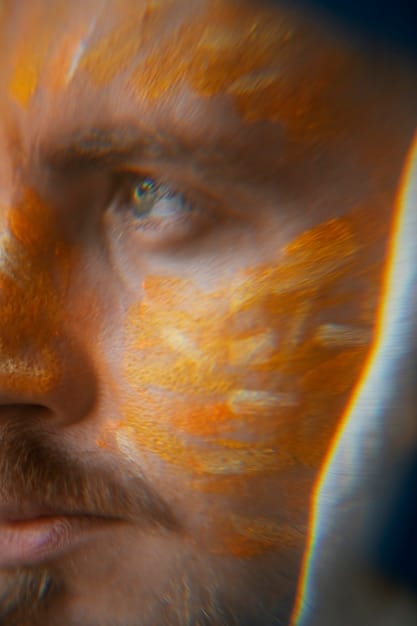
Green Eyes: Enhancing Their Enigmatic Allure
Green eyes, often considered rare and captivating, possess a natural vibrancy that can be dramatically amplified with the right eyeshadow shades. To truly unlock their enigmatic allure, look to colors with red or purple undertones. These hues, positioned opposite green on the color wheel, create a stunning contrast that makes green eyes appear even more vivid and striking.
While the idea of wearing red eyeshadow might seem daunting, it’s typically the more accessible shades of plum, burgundy, and warm browns with a hint of red that work best. These colors complement the green without being overly dramatic, making them suitable for both everyday wear and special occasions. The goal is to highlight the unique golden or emerald flecks often found within green irises.
The Richness of Purple and Plum
Purple, in its many incarnations, is arguably the most flattering color for green eyes. From soft lavenders to deep aubergines, purple shades bring out the verdant tones in green eyes. A palette featuring a range of purples, combined with neutral browns, can provide endless possibilities for both subtle enhancements and bold statements.
- Plum and Burgundy: Deep, rich shades that add sophistication and warmth, making green eyes pop.
- Mauve and Lavender: Softer, more romantic purples ideal for a gentle, ethereal look.
- Rose Gold and Copper: Metallic shades with a reddish tint that provide a beautiful, subtle contrast.
Beyond purples, certain warm browns and earthy tones can also be incredibly flattering. Look for browns with red or golden undertones, as these will harmonize with the warmth often present in green eyes. Avoid blues and cool-toned greens, as they tend to blend in rather than provide the contrast needed to make green eyes stand out. However, if your green eyes have blue undertones, a very subtle cool brown or grey might work in moderation.
When selecting an eyeshadow palette for green eyes in 2025, prioritize versatility. A palette that includes a mix of matte plums, shimmery rose golds, and a few transition browns will allow you to create a range of looks. Experiment with a smoky plum eye for evenings or a soft mauve wash for daytime. Remember, the key is to choose shades that make your green eyes the focal point, enhancing their natural beauty and adding to their captivating charm.
Brown Eyes: A Canvas of Limitless Possibilities
Brown eyes, often perceived as universal, are anything but ordinary. They are a versatile canvas, capable of pulling off virtually any eyeshadow color, from vibrant jewel tones to subtle neutrals. The real magic in choosing the right palette for brown eyes lies in understanding their inherent warmth and depth, and how different shades can evoke various moods and enhance specific undertones within the iris.
While brown eyes can wear almost anything, certain colors will make them truly sparkle. Blues, greens, and purples are particularly effective because they offer a striking contrast to the warm, earthy tones of brown. Whether your brown eyes are light hazel, deep espresso, or a rich chocolate, there’s a spectrum of shades that can make them appear more luminous and multidimensional.
Exploring Vibrant Hues
To make brown eyes stand out, don’t shy away from color. Jewel tones are especially flattering as they provide a rich and luxurious contrast. Think emerald green, sapphire blue, or amethyst purple. These bold choices can transform a simple look into something truly captivating.
- Emerald Green: Adds a sophisticated pop, especially for brown eyes with hints of green or gold.
- Deep Sapphire Blue: Creates a dramatic and striking contrast, making brown eyes appear brighter.
- Rich Amethyst Purple: Offers a luxurious depth that complements the warmth of brown eyes beautifully.
For more everyday wear, neutrals like taupe, bronze, and champagne are excellent choices. Bronze and gold shades bring out the warmth in brown eyes, while cooler neutrals like grey or silver can add a touch of sophistication. A palette that includes a variety of these versatile neutrals, along with a few vibrant pops of color, will provide endless options for different occasions.
Consider the undertones in your brown eyes. If they lean more towards golden or amber, warm shades like gold, bronze, and warm browns will enhance their luminosity. If they have cooler undertones, or hint at grey, then cool blues, silvers, and charcoal greys can create a stunning effect. In 2025, the trend for brown eyes is about embracing their chameleon-like quality—experiment with different color families and finishes. From smoky eyes with a hint of blue to a soft wash of green, brown eyes truly are a playground for color, limited only by your imagination.
Hazel Eyes: Mastering the Chameleon Effect
Hazel eyes are a unique and frequently misunderstood eye color. Often described as chameleon-like, they feature a fascinating blend of green, brown, and sometimes even gold or amber flecks. This dynamic nature means that the “right” eyeshadow can subtly shift their dominant hue, making them appear more green, more brown, or accentuating their golden specks. The key to mastering hazel eyes in 2025 is to pinpoint which aspect you wish to highlight and choose your palette accordingly.
The versatility of hazel eyes is both a blessing and a slight challenge. Unlike a solid eye color, hazel requires a more nuanced approach. By selecting shades that complement either the green or brown elements, you can control which aspect of your eyes stands out the most. This means a single hazel-eyed individual might have several go-to palettes, each designed to achieve a different effect.
Highlighting Green or Gold Undertones
To bring out the green in hazel eyes, focus on shades that complement green, such as plums, purples, and deep jewel tones. For accentuating the golden or amber flecks, warm, earthy tones like coppers, bronzes, and rich browns will work wonders. The choice depends on the specific overall look you are aiming for.
- Plum and Burgundy: Excellent for intensifying the green flecks within hazel eyes, creating a more verdant look.
- Copper and Bronze: These warm metallics will make the golden or amber tones in hazel eyes truly shimmer.
- Forest Green or Moss: Paradoxically, certain deep greens can enhance the existing green, creating a richer, more cohesive look.
Avoid very cool blues or silvers if your hazel eyes lean more towards brown, as these can sometimes wash out the warmth of the iris markings. However, if your hazel eyes have distinct blue-grey flecks, then subtle cool tones might be an option. Remember, the goal is to enhance, not overpower, the multifarious nature of your hazel eyes.
In 2025, for those with hazel eyes, experimentation is key. A versatile palette that includes a mix of warm browns, deep plums, and perhaps a shimmery gold or copper will be your best friend. Try applying the plum shades to emphasize the green and then a touch of copper on the inner corner for warmth. Observing how your eyes react to different shades will ultimately lead you to the perfect palette for your unique chameleon eyes, allowing you to control which facet of their beauty you wish to reveal.
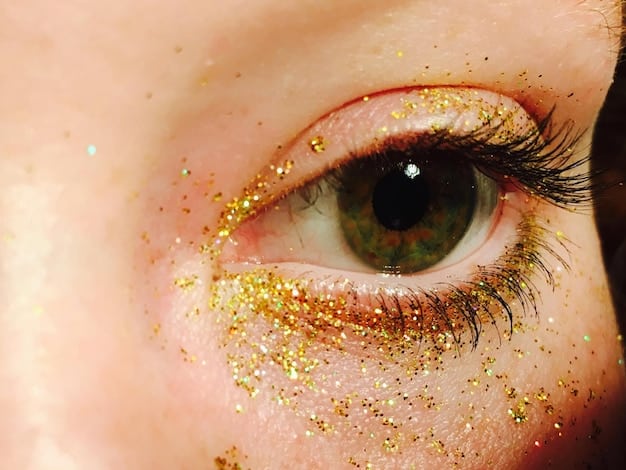
Choosing Palettes Based on Skin Undertone and Hair Color
While eye color is a strong determinant in eyeshadow selection, a truly masterful makeup application considers the holistic picture: your skin’s undertone, hair color, and even personal style. These elements work in concert to create a harmonious and flattering look. Ignoring them can lead to a disjointed appearance, even if the eyeshadow perfectly complements your eye color alone. In 2025, integrated beauty is about understanding how these features interact.
Your skin’s undertone (warm, cool, or neutral) plays a significant role in how colors appear on your complexion. Warm undertones (often with golden or peachy hues) tend to look best with warm eyeshadows, while cool undertones (with pink or blue hues) are enhanced by cooler shades. Neutral undertones have the most flexibility. Similarly, hair color, whether it’s ash blonde, fiery red, or deep brunette, adds to your overall warmth or coolness and should influence your palette choice for maximum impact.
Harmonizing with Skin Undertone
Selecting eyeshadows that align with your skin’s undertone ensures your makeup looks seamless and natural, rather than clashing. This is especially important for transition shades and base colors in a palette.
- Warm Undertones: Opt for warm browns, golds, olives, and reddish-purples.
- Cool Undertones: Lean towards cool grays, deep blues, true purples, and silvers.
- Neutral Undertones: Enjoy the freedom to experiment with both warm and cool shades.
Hair color, too, can either amplify or mute certain eyeshadow choices. For instance, a person with warm, golden blonde hair might find that cool-toned eyeshadows wash them out, even if they have blue eyes. Conversely, someone with cool, dark hair might find warm eyeshadows too stark. It’s about creating a balanced composition across your entire face, where every element contributes to a cohesive aesthetic.
Don’t be afraid to experiment, but use your skin and hair as guiding principles. A redhead with green eyes might find that a warm, coppery eyeshadow not only makes her eyes pop but also enhances her flaming locks. A person with ash-blonde hair and blue eyes might find that a cool, slate grey eyeshadow feels more harmonious than a warm bronze. The goal in 2025 is to select a palette that not only highlights your beautiful eye color but also enhances your overall natural coloring, creating a look that is uniquely and beautifully you, from head to shoulders, and beyond.
Palette Size and Versatility: Your 2025 Essentials
In the evolving landscape of 2025 beauty, the sheer number of eyeshadow palettes available can be overwhelming. Beyond color selection, considerations like palette size, finishes, and overall versatility are crucial for building a functional and inspiring makeup collection. It’s no longer about owning every trendy palette; it’s about curating a selection that genuinely serves your needs, lifestyle, and aesthetic preferences without unnecessary clutter or duplication.
The ideal palette offers a thoughtful combination of shades and finishes that allow for a range of looks, from subtle daytime enhancements to dramatic evening statements. This means analyzing whether a palette provides enough transition shades, depth colors, and lid shimmers to create complete looks, rather than just a few isolated vivid colors that lack context. Versatility is the cornerstone of a smart makeup investment.
The Core of a Versatile Palette
When selecting a palette, look for a balance of mattes, shimmers, and perhaps a satin or metallic finish. Mattes are essential for definition and blending, shimmers add light and dimension, and metallics provide a high-impact glint.
- Balance of Mattes and Shimmers: Ensures you can create both subtle and dramatic looks.
- Multiple Transition Shades: Crucial for seamless blending and creating depth.
- Light, Medium, and Deep Tones: Allows for contouring, highlighting, and building intensity.
- Mix of Warm and Cool Tones: Provides flexibility for different moods and occasions, or to suit varying undertones in your eye color.
Consider your daily routine and how much time you dedicate to makeup. If you prefer quick, effortless looks, a compact palette with a few key shades might be more practical than a large, multi-pan collection. Conversely, if you enjoy experimenting and creating diverse looks, a larger, more comprehensive palette could be a worthwhile investment.
In 2025, many brands are focusing on more sustainable and mindful consumption. This translates to smaller, more curated palettes that are designed for maximum impact and versatility, rather than excessive pans. Consider palettes that allow for depoting or have refillable options. Ultimately, the best palette for you is one that not only complements your eye color, skin tone, and hair color but also integrates effortlessly into your lifestyle, empowering you to create stunning looks with ease and confidence, day after day.
Advanced Techniques & Trends for 2025 Eyeshadow Application
As we step further into 2025, eyeshadow application continues to evolve beyond basic blending. Modern techniques and emerging trends offer innovative ways to wear color, focusing on enhancing natural features with precision and creativity. Understanding these advanced applications allows you to move past simple washes of color and truly sculpt, define, and illuminate your eyes in sophisticated ways. It’s about adding a professional edge to your makeup routine, making your chosen palette work harder for you.
Current trends emphasize thoughtful placement, textural contrasts, and the strategic use of lighter and deeper shades to create dimension. This includes techniques like “spotlight,” “halo,” and “reverse smoky” eyes, which were once considered editorial but are now increasingly popular for everyday wear. The key is to blend seamlessly while maintaining crisp definitions where needed, ensuring your eye makeup appears deliberate and polished.
Strategic Placement and Blending
Beyond simply applying color, where and how you place your eyeshadow can dramatically alter your eye shape and the impact of the color itself. Consider your eye shape when applying these techniques for the most flattering results.
- Spotlight Eyes: Darker shades on the inner and outer corners of the lid, with a lighter, shimmery shade in the center, creating a spotlight effect that makes eyes appear larger and more open.
- Halo Eyes: Similar to spotlight, but the lighter shade is applied more broadly across the center of the lid, blending outwards into the darker shades, creating a soft, luminous glow.
- Reverse Smoky Eye: Deep, darker shades applied along the lower lash line, with lighter or neutral shades on the upper lid. This unexpected placement offers a modern twist on the classic smoky eye.
- Wet Look Finishes: Using glosses or specialized liquid shadows to create a shiny, almost dewy effect on the lids—a popular editorial trend gaining mainstream traction.
Another emerging trend is the emphasis on single-shadow looks, often using a cream or liquid formula for a quick, impactful wash of color. This minimalist approach focuses on the quality and richness of one shade, applied strategically for a high-fashion, effortless vibe. Similarly, graphic liner, often drawn with eyeshadow as opposed to traditional liquid liner, is seeing a resurgence, allowing for bold, artful statements with less rigidity than liquid formulas.
Don’t be afraid to experiment with these techniques, even if they seem advanced. Start small, perhaps by adding a touch of shimmer to the center of your lid or darkening your lower lash line with a complementary shade. Practice makes perfect, and trying new methods with your carefully selected eyeshadow palette will not only enhance your skills but also unleash new creative possibilities for truly captivating eye looks in 2025 and beyond.
| Key Point | Brief Description |
|---|---|
| 🎨 Color Harmony | Utilize the color wheel to find shades that truly make your eye color pop. |
| 👁️ Eye-Specific Shades | Blue eyes: warm browns, coppers; Green eyes: plums, burgundies; Brown eyes: blues, greens. |
| ✨ Holistic Approach | Consider skin undertone, hair color, and personal style for overall balance. |
| 💡 Modern Techniques | Experiment with spotlight, halo, and wet-look finishes to elevate your eyes. |
Frequently Asked Questions About Choosing Eyeshadow Palettes
▼
For blue eyes, warm tones like coppers, bronzes, peaches, and rusty browns are highly effective. These shades offer a striking contrast that makes blue eyes appear more vibrant and intense. Think about rich terracottas or shimmering golds to truly make them pop, moving beyond basic neutrals for added depth and sparkle.
▼
Green eyes are best complemented by shades with red or purple undertones, such as plums, burgundies, and deep mauves. These colors provide a rich contrast that enhances the green. Additionally, rose gold and true copper tones can bring out any golden flecks in green eyes, making them appear more luminous and mysterious.
▼
Brown eyes are incredibly versatile and can wear almost any color, making them quite forgiving. There are generally no “forbidden” colors. However, some very light, cool pastels might not provide enough contrast to make the deep tones of brown eyes truly stand out. Focus on jewel tones and rich neutrals for maximum impact and versatility.
▼
Skin undertone significantly influences how eyeshadow colors appear. Warm undertones (peachy, golden) complement warm eyeshadows like golds, olives, and warm browns, creating a harmonious look. Cool undertones (pink, blue) are enhanced by cool blues, silvers, and true purples. Aligning with your undertone ensures overall makeup harmony.
▼
In a “spotlight” eye, darker shades are placed on the inner and outer corners, with a lighter shimmer in the center of the lid. A “halo” eye is similar, but the lighter, often shimmery, shade is applied more broadly over the central eyelid, blending softly into the darker perimeter, creating a softer, luminous, and more diffused glow around the entire eye area.
Conclusion
Choosing the right eyeshadow palette for your eye color is an art that blends color theory with personal expression. By understanding the complementary hues for blue, green, brown, and hazel eyes, and considering the broader context of your skin undertone and hair color, you can unlock the full potential of your gaze. Furthermore, embracing modern techniques and continually experimenting with new applications will ensure your eye makeup remains fresh, captivating, and perfectly tailored to your unique beauty as we navigate the evolving trends of 2025. It’s about empowering smarter choices, leading to more confident and stunning results.
